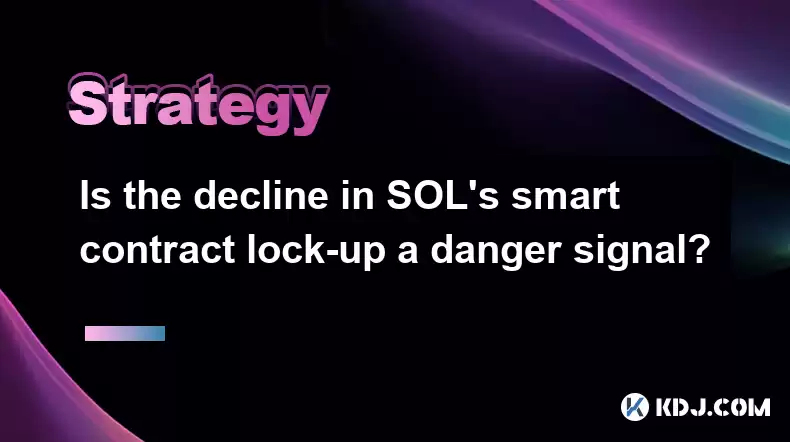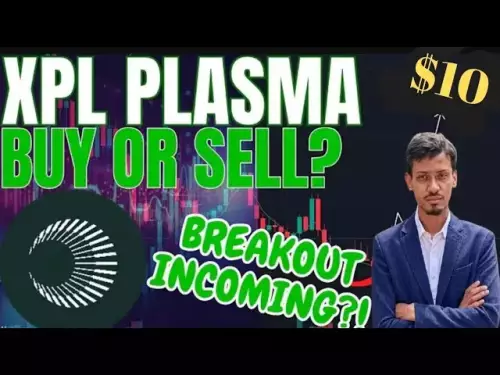-
 bitcoin
bitcoin $110918.433029 USD
-1.69% -
 ethereum
ethereum $3996.872473 USD
-2.43% -
 tether
tether $1.000594 USD
0.00% -
 bnb
bnb $1178.871834 USD
-2.38% -
 xrp
xrp $2.413973 USD
-3.47% -
 solana
solana $194.341461 USD
-4.24% -
 usd-coin
usd-coin $0.999963 USD
-0.03% -
 tron
tron $0.320092 USD
0.92% -
 dogecoin
dogecoin $0.196919 USD
-3.42% -
 cardano
cardano $0.669585 USD
-3.63% -
 hyperliquid
hyperliquid $37.485952 USD
-3.58% -
 ethena-usde
ethena-usde $1.000026 USD
-0.02% -
 chainlink
chainlink $18.018220 USD
-5.13% -
 bitcoin-cash
bitcoin-cash $523.879267 USD
-2.41% -
 stellar
stellar $0.324655 USD
-3.67%
Is the decline in SOL's smart contract lock-up a danger signal?
The decline in SOL's smart contract lock-up raises concerns about waning interest in Solana, potentially impacting its market performance and ecosystem growth.
Apr 26, 2025 at 05:56 pm

The recent decline in SOL's smart contract lock-up has raised concerns among investors and market analysts alike. SOL, the native cryptocurrency of the Solana blockchain, has been experiencing a noticeable decrease in the value of assets locked within its smart contracts. This phenomenon can be seen as a potential danger signal for several reasons. The amount of assets locked in smart contracts is often used as an indicator of the health and activity of a blockchain ecosystem. A decline might suggest waning interest or confidence in the platform, which could have broader implications for SOL's market performance and long-term viability.
Understanding Smart Contract Lock-up
Smart contract lock-up refers to the total value of assets that are held within smart contracts on a blockchain. For Solana, this includes tokens, NFTs, and other digital assets that are part of decentralized applications (dApps) and other protocols running on the network. The lock-up value is a crucial metric because it reflects the level of engagement and investment in the ecosystem. When this value decreases, it might indicate that users are withdrawing their assets, possibly due to concerns about the platform's security, scalability, or overall market sentiment.
Analyzing the Decline in SOL's Smart Contract Lock-up
The decline in SOL's smart contract lock-up can be attributed to several factors. One possible reason is the recent market volatility that has affected many cryptocurrencies. Investors might be moving their assets to more stable investments or simply cashing out due to uncertainty. Another factor could be specific issues within the Solana network, such as outages or security breaches that have been reported in the past. These events can erode trust and lead to a decrease in locked assets.
To understand the extent of the decline, it's important to look at data from reliable sources. Platforms like DefiLlama and Dune Analytics provide detailed statistics on the total value locked (TVL) in various blockchains, including Solana. According to recent data, there has been a significant drop in TVL on Solana, which aligns with the observed decline in smart contract lock-up.
Potential Implications for SOL and the Solana Ecosystem
The decline in smart contract lock-up could have several implications for SOL and the broader Solana ecosystem. Firstly, it might affect the token's price, as lower lock-up values can lead to increased selling pressure. If more investors decide to sell their SOL due to concerns about the platform's health, this could exacerbate the downward trend in the token's value.
Secondly, a decrease in locked assets can impact the development and growth of dApps on Solana. Developers might be less inclined to build on a platform where user engagement and investment are declining. This could lead to a vicious cycle where fewer dApps result in even less user activity and lower lock-up values.
Lastly, the decline might signal broader issues within the Solana ecosystem. If the platform is struggling to maintain user interest and investment, it could indicate underlying problems that need to be addressed. This might include technical issues, governance challenges, or competition from other blockchains that are attracting more users and developers.
Assessing the Danger Signal
To determine whether the decline in SOL's smart contract lock-up is indeed a danger signal, it's important to consider other metrics and indicators. Network activity, such as the number of transactions and active addresses, can provide additional insights into the platform's health. If these metrics are also declining, it strengthens the case that the drop in lock-up value is a cause for concern.
Market sentiment is another crucial factor. Analyzing social media, forums, and other platforms where crypto enthusiasts discuss Solana can reveal whether the decline in lock-up value is a widespread concern or just a temporary blip. Tools like Sentiment and LunarCrush can help gauge the overall sentiment towards SOL and the Solana ecosystem.
Steps to Monitor and Respond to the Decline
For investors and stakeholders in the Solana ecosystem, it's important to monitor the situation closely and take appropriate actions. Here are some steps that can be taken:
- Regularly check TVL data: Use platforms like DefiLlama and Dune Analytics to keep track of the total value locked in Solana's smart contracts. This will help you stay informed about any further declines or potential recoveries.
- Monitor network activity: Keep an eye on transaction volumes, active addresses, and other network metrics to get a comprehensive view of Solana's health.
- Stay updated on market sentiment: Use sentiment analysis tools to understand how the broader crypto community is reacting to the decline in SOL's smart contract lock-up.
- Diversify your investments: If you're concerned about the implications of the decline, consider diversifying your crypto portfolio to mitigate potential risks.
- Engage with the Solana community: Participate in discussions on forums and social media to stay informed about any developments or initiatives aimed at addressing the decline.
Frequently Asked Questions
Q: How can I check the current TVL on Solana?A: You can check the current total value locked (TVL) on Solana by visiting platforms like DefiLlama or Dune Analytics. These websites provide real-time data on the value of assets locked in Solana's smart contracts.
Q: What other metrics should I look at to assess Solana's health?A: In addition to TVL, you should monitor network activity metrics such as transaction volumes and active addresses. These can be found on Solana's official explorer or through third-party analytics platforms like Nansen or Messari.
Q: Are there any initiatives by the Solana team to address the decline in smart contract lock-up?A: The Solana team has been actively working on improving the platform's performance and security. They have released updates and patches to address past issues and are continuously engaging with the community to gather feedback and implement improvements.
Q: How does the decline in SOL's smart contract lock-up compare to other blockchains?A: Comparing the decline in SOL's smart contract lock-up to other blockchains involves looking at similar metrics for platforms like Ethereum, Binance Smart Chain, and others. Platforms like DefiLlama provide comparative data that can help you understand how Solana's situation stacks up against its competitors.
Disclaimer:info@kdj.com
The information provided is not trading advice. kdj.com does not assume any responsibility for any investments made based on the information provided in this article. Cryptocurrencies are highly volatile and it is highly recommended that you invest with caution after thorough research!
If you believe that the content used on this website infringes your copyright, please contact us immediately (info@kdj.com) and we will delete it promptly.
- DOGE, AlphaPepe, and the Crypto Explosion: What's Next?
- 2025-10-17 04:25:14
- Dogecoin, Bitcoin, and Ethereum: Navigating the Crypto Current
- 2025-10-17 04:25:14
- Dogecoin, Shiba Inu, and Remittix: Meme Coins vs. Real Utility
- 2025-10-17 05:05:14
- Toncoin's Next Move: Catalysts and Considerations for Investors
- 2025-10-17 05:05:14
- KGeN Token's Wild Ride: Price Surge, Plunge, and What It Means for Crypto
- 2025-10-17 05:10:01
- Coinbase, Altcoins, and DeepSnitch AI: Navigating the Crypto Landscape
- 2025-10-17 04:45:14
Related knowledge

Practical parameter settings for a Bitcoin multi-timeframe moving average system
Sep 18,2025 at 10:54pm
Optimizing Timeframe Combinations for Bitcoin Trading1. Selecting appropriate timeframes is crucial when building a multi-timeframe moving average sys...

How can I filter out false breakouts in Dogecoin high-frequency trading?
Sep 22,2025 at 01:00am
Understanding False Breakouts in Dogecoin Trading1. A false breakout occurs when Dogecoin's price appears to move beyond a defined support or resistan...

Techniques for identifying tops and bottoms in the Bitcoin on-chain NVT model
Sep 20,2025 at 07:54pm
Understanding the NVT Model in Bitcoin Analysis1. The Network Value to Transactions (NVT) ratio is often described as the 'P/E ratio' of the cryptocur...

What does the surge in open interest in Bitcoincoin futures mean?
Sep 20,2025 at 11:18pm
Understanding the Surge in Dogecoin Futures Open Interest1. A surge in open interest within Dogecoin futures indicates a growing number of active cont...

How can I use the Ethereum USDT premium to gauge market sentiment?
Sep 18,2025 at 11:55pm
Understanding the Ethereum USDT Premium1. The Ethereum USDT premium refers to the price difference between USDT (Tether) traded on Ethereum-based plat...

What should I do if Ethereum staking yields decline?
Sep 20,2025 at 06:18am
Understanding the Causes Behind Declining Ethereum Staking Yields1. The Ethereum network transitioned to a proof-of-stake consensus mechanism with the...

Practical parameter settings for a Bitcoin multi-timeframe moving average system
Sep 18,2025 at 10:54pm
Optimizing Timeframe Combinations for Bitcoin Trading1. Selecting appropriate timeframes is crucial when building a multi-timeframe moving average sys...

How can I filter out false breakouts in Dogecoin high-frequency trading?
Sep 22,2025 at 01:00am
Understanding False Breakouts in Dogecoin Trading1. A false breakout occurs when Dogecoin's price appears to move beyond a defined support or resistan...

Techniques for identifying tops and bottoms in the Bitcoin on-chain NVT model
Sep 20,2025 at 07:54pm
Understanding the NVT Model in Bitcoin Analysis1. The Network Value to Transactions (NVT) ratio is often described as the 'P/E ratio' of the cryptocur...

What does the surge in open interest in Bitcoincoin futures mean?
Sep 20,2025 at 11:18pm
Understanding the Surge in Dogecoin Futures Open Interest1. A surge in open interest within Dogecoin futures indicates a growing number of active cont...

How can I use the Ethereum USDT premium to gauge market sentiment?
Sep 18,2025 at 11:55pm
Understanding the Ethereum USDT Premium1. The Ethereum USDT premium refers to the price difference between USDT (Tether) traded on Ethereum-based plat...

What should I do if Ethereum staking yields decline?
Sep 20,2025 at 06:18am
Understanding the Causes Behind Declining Ethereum Staking Yields1. The Ethereum network transitioned to a proof-of-stake consensus mechanism with the...
See all articles










































































